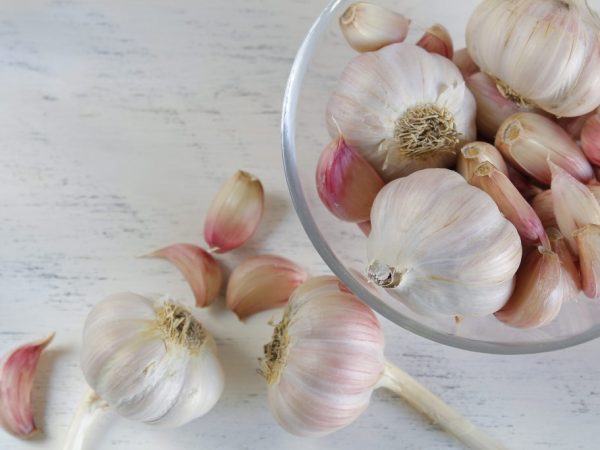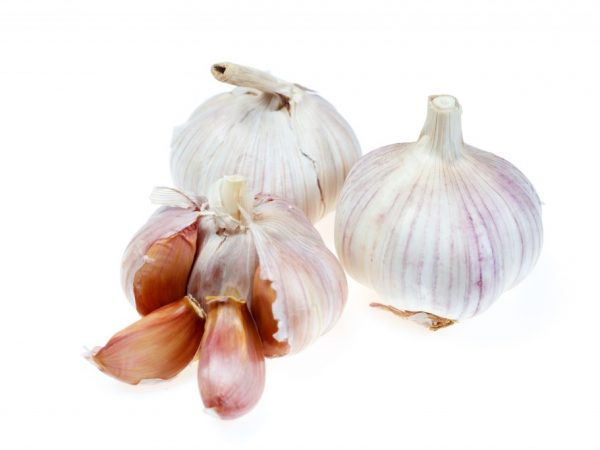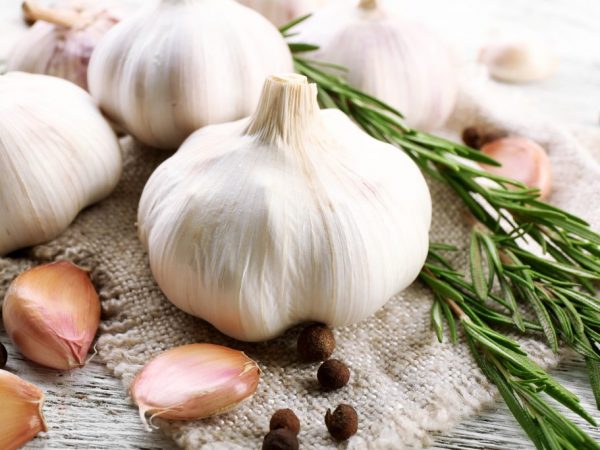Biochemical composition of garlic
The chemical composition in garlic is rich in vitamins and minerals necessary for the proper functioning of the human body. Its medicinal properties have been used in traditional and folk medicine for many years. According to some of the versions, Dzungaria is the birthplace of garlic.

Biochemical composition of garlic
Chemical composition of the product
The chemical composition of garlic is very rich in vitamins. It contains vitamins:
- group B, necessary for the desired synthesis in the human body;
- E, which is responsible for the structure of the dermis, is a powerful antioxidant;
- C, necessary to maintain the functioning of the immune system;
- K plays an important role in the metabolic processes of bone tissues;
- folic acid, which supports the strength of the female body;
- biotin;
- iodine;
- Fe;
- magnesium and many others.
In addition to all of the above vitamins, the vegetable contains fiber, amino acids and esters, which are a powerful aphrodisiac. Some nutrients are found more in the stems than in the root vegetables themselves. For example, the vitamin C content in the head is 70 mg, and in the ground part - 150 mg. In addition, greens contain carotene (vitamin A), which is not found in root vegetables.
Nutritional value of the product is 149 kcal. The chemical composition will largely depend on the season. The most demanded substances in the composition of garlic are polysacrose and carbohydrates. Insulin and sucrose are most contained in the heads in the autumn. By spring, these substances break down into fructose and glucose.
Of all the foods, only garlic contains the mineral thiamine. The most valuable are:
- ascorbic acid (mainly found in the leaves);
- carotene;
- a nicotinic acid;
- riboflavin.
The nutritional value

Garlic is used in diets
Nutritional value of the product per 100 g:
- 149 kcal;
- proteins 6.5 g;
- fats 0.5 g;
- carbohydrates 29.9 g;
- fiber 1.5 g;
- water 60 g.
The nutritional value of the product allows it to be used in some diets, to lower body mass index, by removing toxins and cholesterol. The beneficial properties of root crops are due to the rich vitamin and mineral complex. The most valuable substance is phytoncides, which can effectively fight even the bacillus of tuberculosis. Sulfur-containing substances promote vasodilation and effectively eliminate blood clots, increase the elasticity of capillary tissues
Trace elements in the vegetable
The product is enriched with trace elements. In cloves, their content is within 3.7%, in the ground part - about 8.8%. In total, garlic contains 17 minerals: K, Se, P, Ge, Ca, Mn, Mg, Zr, Na and others.
Germanium
Germanium is found only in this vegetable. The substance is responsible for strengthening the walls of the capillary joints. Helps to improve the structure and permeability of blood vessels. Consuming vegetables in reasonable amounts can be an excellent prevention of varicose veins.Germanium helps to activate the movement of oxygen through the vessels, which is an excellent stimulation of the immune system.
Selenium
Selenium is a powerful antioxidant that disinfects toxins in the liver. The vegetable is primarily used as a medicine for poisoning. Selenium participates in the processes of regeneration of the dermis, nail plates, hair. The selenium content depends on the composition of the soil. In the northwestern regions, the soil composition is poor, so it is recommended to grow garlic in the southern areas.
Iodine
Iodine is the main element responsible for the synthesis of substances in the body. Plays a role in the regulation of heat exchange, protein and water metabolism. It is used as a prophylaxis for thyroid diseases. Garlic contains more than 100 sulfur-containing elements. Sulfides can completely destroy a number of dangerous bacteria such as:
- staphylococci;
- typhus sticks;
- fungi and yeast.
Aspirin-like trace elements thin the blood. Phytoncides are very valuable substances. They are similar to antibiotics and can kill many viruses in a short time. Phytoncides are capable of destroying a tubercle bacillus in 5 minutes.
Product benefits

There are a lot of vitamins in the product
Trace elements and vitamins contained in garlic help to quickly destroy bacteria and fungi that provoke the development of serious ailments. Benefits for the human body:
- dilates blood vessels;
- is a prophylactic agent for varicose veins and vascular occlusion;
- increases the body's resistance to infections;
- acts as a diuretic;
- relieves pain.
Garlic contains allicin, which forms allin. It is this substance that gives the plant that unique taste, smell and destroys many viruses. Its antibacterial effect is retained even if it is diluted with water in proportions of 1: 125,000. It is a fact established by scientists that among the peoples who often use garlic in the preparation of their dishes, the incidence of cancer is much lower.
Sulfur-containing substances are of particular value. They are a real antidote for toxin poisoning. Sulfides make the molecules of toxins inactive, inert, and then the body has the opportunity to remove them quickly and without loss to itself.
For the digestive tract
Since ancient times, this product has been used in the treatment of gastrointestinal diseases. The vegetable is a choleretic agent, so it is recommended to add it to fatty and heavy meals. Nutritionists recommend using this vegetable to cleanse the body of slagging.
In addition, the root vegetable is a natural anthelmintic. For those with stool disorders such as persistent constipation, it is recommended to consume this vegetable. After a few days, the problem can be completely resolved.
For the cardiovascular system
Garlic is indicated for the use of hypertensive patients. The substances contained in its composition help to expand blood vessels, improve their smoothness and patency. Garlic helps remove cholesterol from the body and thins the blood.
It is an excellent prevention of such diseases:
- multiple sclerosis;
- stroke;
- heart attack;
- varicose veins;
- thrombosis.
For cosmetology
In the treatment of many cosmetic problems, masks based on garlic gruel are used. It copes well with baldness, strengthens the nail plates, heals skin lesions. Many dermatologists prefer to use natural garlic masks to treat scalp problems.
They stimulate hair growth and actively fight against fungi that provoke the appearance of pustules on the body. The best effect is observed from a vegetable boiled, fresh or pickled. In addition, the plant is considered one of the most powerful aphrodisiacs.
Contraindications
Like any product, garlic has its own contraindications and side effects.
- It is not recommended to use the root vegetable for people who have problems with the gastrointestinal tract, accompanied by increased acidity or excessive bile secretion. You can not use the vegetable for people suffering from hemorrhoids and epileptic seizures.
- It is not recommended to use the product for patients with renal diseases such as nephritis and nephrosis.
- The vegetable is strictly contraindicated for asthmatics.
- The vegetable should not be consumed by pregnant and lactating women. Eating a vegetable in large quantities can provoke a very strong intoxication. For medicinal purposes, the root crop should be used only as directed by a doctor.
Final part
Garlic is one of the most sought after foods all over the world. People learned about its healing properties many thousands of years ago. There are references to him dating back to the times of Ancient Egypt.
The vegetable is an unpretentious plant, so it can be grown anywhere in the world. But, the chemical composition will largely depend on the type of soil. Northwestern soils are usually sparse in composition, so it is recommended to grow root crops in the southern areas.
What nutrients will prevail in the composition mainly depends on the season. In autumn, the cloves contain more insulin and sucrase. In the spring, they are converted to glucose and sucrose.


